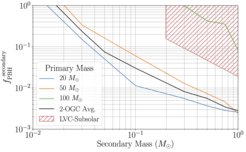Listening for the unique reverberations of merging primordial black holes
Results from a novel search for mergers of stellar-mass black holes with sub-solar mass black holes
Researchers look for signs of primordial black holes, which formed in the early Universe before stars existed, by searching for a distinct type of gravitational waves. Primordial black holes could account for a part or all of dark matter. They may also explain the origin of some of the black holes observed merging by gravitational-wave observatories. However, these mergers may also be explained as the more mundane consequence of the evolution and death of heavy stars. Therefore it is important to search for unequivocal evidence of primordial black holes. AEI researchers have conducted the first search for a new class of black hole mergers which previous searches may have missed. They looked for the unique gravitational-wave signature of a black hole with mass dozens of times larger than the Sun merging with one that is comparatively light, starting from only ten times the mass of Jupiter up to the mass of the Sun. These lighter black holes are not heavy enough to have formed from the death of stars but could be primordial. The observed lack of these mergers in public LIGO data places new limits on the Universe's potential population of primordial black holes.
Paper abstract
We present the first search for gravitational waves from the coalescence of stellar mass and sub-solar mass black holes with masses between 20 – 100 M⊙ and 0.01 – 1 M⊙ (10−103 M J ), respectively. The observation of a single sub-solar mass black hole would establish the existence of primordial black holes and a possible component of dark matter. We search the ∼164 days of public LIGO data from 2015 – 2017 when LIGO-Hanford and LIGO-Livingston were simultaneously observing. We find no significant candidate gravitational-wave signals. Using this non-detection, we place a 90% upper limit on the rate of 30 − 0.01 M⊙ and 30 − 0.1 M⊙ mergers at < 1.2×106 and < 1.6 × 104 Gpc −3yr−1, respectively. If we consider binary formation through direct gravitational-wave braking, this kind of merger would be exceedingly rare if only the lighter black hole were primordial in origin (< 10−4 Gpc −3yr−1). If both black holes are primordial in origin, we constrain the contribution of 1(0.1) M⊙ black holes to dark matter to < 0.3(3)%.













